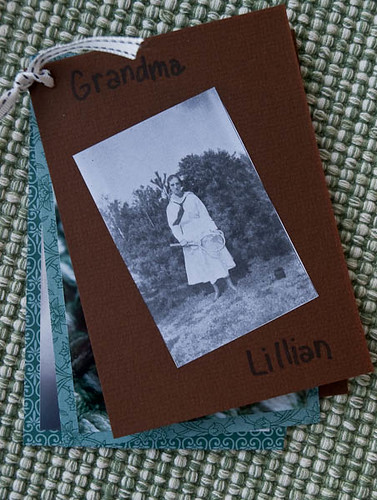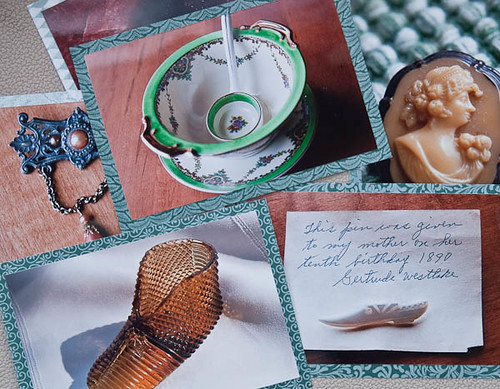Grandma and Brother © 2010 Bo Mackison
This is the third post in the Memoir Project, a series on documenting your life story. The first two projects in the Memoir Project were writing projects. Now is a good time to branch out and add a multimedia touch.
Let’s add an easy photography project.
No need to have an expensive camera or a camera with fancy settings unless that is the kind of camera you love to use. A basic camera is fine. Or a phone camera. Or a three dollar disposable camera from the corner store.
We often annotate our photographs when we organize them.
We take photos. Then we add information on the back — date, place, names. Important information. However in this project, the photographs are not the only part of the project. The writing is just as important.
My photo booklet — in the photograph below — focuses on an important person in my life.
You may want to do a similar project with the focus on a person, or you may want to feature your favorite books, art, foods. You can photograph the place where you live, including details that make your house a special place. You can do a photo shoot documenting your typical activities on a typical day. You are limited in subject matter only by your imagination!
I chose to write about my grandmother, one of the more influential women in my life, who lived to be 91 years old. I have many fond memories of my grandmother — I lived with her until I left home to attend college — but I wanted to write about her using a multifaceted approach.
I chose to do a project about objects and mementos she had given me, both as a child and as an adult. I photographed these items and included them in a booklet, using each photo as an evocative prompt for writing. Here are the directions for making a similar booklet. You can adapt the directions to your own project.
https://oleoalmanzora.com/oleoturismo-en-pulpi/ How-To Directions for Turning a Photo Booklet into a Memoir Keepsake:
1. I only have a few things from my grandmother. I went through my home collecting those items. In ten minutes, I’d found several pieces of jewelry, a collectible miniature shoe, a lucky buckeye, and my most beloved treasure, a gravy bowl that my grandparents had received as a wedding gift.
2. I took photos of each object. Again, nothing fancy. Try to use natural lighting if possible–set the items up on a table near a window, or even outside, but don’t photograph items in direct sunlight. A shaded area is fine. It is also better to avoid flash if you shoot indoors, but don’t get hung up on the photography. Just take the photos. Take several photos of each item, so you can choose the best photo of each item.
3. Make prints of a photograph of each object.
4. Mount the photographs on a backing paper. You can use a variety of papers, a heavy weight paper works best. I used a decorative paper from a local arts and crafts store.
5. I created a front and back page for the booklet. I photocopied a vintage photo of my grandmother — don’t use an original! — and glued it to the front of the booklet. Use any photograph, drawing, or title that captures the focus and spirit of your book.
6. Punch a hole in the top left corner of each photo and the cover pages.
7. Tie the two covers and all the photographs together with a ribbon or use a metal binder ring (can be purchased at an office store.)
8. Once you complete your booklet, the writing begins. (Or sooner, if you are inspired.) When using photographs of special objects, thinking about the memorabilia will bring back many memories. Write whatever comes to mind on the back of each photograph. No over-thinking, just a quick written sketch will do.
9. Keep the booklet handy. You can add information as you recall more details. Once in a while I find another item from my grandmother. (Just last week, I realized my rolling-pin had come from her kitchen.) Take photographs and update the booklet as needed.
Here is a sample of the quick writing I did on the back of the photograph of the gravy boat.
This is my favorite object I have from Grandma. It’s a Noritake china gravy bowl with a matching saucer. My favorite part is the elegant but tiny matching ladle. She and Grandpa Harry received it from his great-aunt when they married in 1919. I remember using it on special occasions such as Thanksgiving dinner. I always loved it, and Grandma gave it to Robert and me the summer we planned our own wedding.
In our family we used the gravy bowl frequently while the kids were growing up. I think whenever we had gravy with a meal, one of the children would ask if we could “please use Great Grandma’s bowl.” The kids used the bowl and tiny ladle while I cautioned them to be careful–I couldn’t help but utter words of warning!–but all three kids, from the time they were barely in school, ladled their own gravy onto their mashed potatoes from the precious china bowl.
We use it to this day, and everyone thinks of it as one of our more valuable family heirlooms.
In the next project, we’ll explore another quick writing prompt and discuss methods for storing your growing memoir stash!









Speak Your Mind